
10 minute read
A Defining Moment
By Nick Hildebrand
Faced with the unprecedented challenge of a global pandemic, Grove City College draws on its vision, institutional strength, and unfailing faith to fulfill its core mission.
On Friday, March 13, as the COVID-19 pandemic was spreading and colleges and universities across the country were sending students home and making plans to shift instruction online, Grove City College President Paul J. McNulty ’80 announced that the College would chart a middle course.
Classes would shift to remote instruction for a month or more, but students could decide for themselves whether they should remain on campus or leave, he wrote in an email to students and their families. The policy was the result of weeks of discussion, thought, and prayer by the administration and members of a task force assembled to evaluate the burgeoning coronavirus crisis and its impact on a community of more than 2,300 students living and learning in close quarters.
McNulty thought the College had threaded the needle and found a solution that protected the health and safety of students, faculty, and staff while maintaining the inherently valuable, in-person residential educational environment the College is known for.
“When the email went out,” he said. “You could hear the cheering on campus. People were excited that they would get to stay.” But, as the hours ticked by that weekend and new mandates and guidelines from the state of Pennsylvania and the Centers for Disease Control were issued, “it became clear that it was untenable,” McNulty said. Rules on crowd sizes, school closings that would impact employees with young children, staffing issues as personal safety concerns rose, and the designation of colleges and universities as “non-essential” businesses by the state would severely impact operations.
Those factors, coupled with the very real possibility that an outbreak on campus could severely strain local health capacity, forced the president’s hand. “I became concerned that we could hurt the community. Could we overrun the hospital? Could we put people’s lives at risk because we’re not doing the responsible thing on campus? What does that campuscommunity relationship look like and how do we best serve those interests? That began to weigh heavier on my mind,” McNulty said. “It was a really tough weekend.”
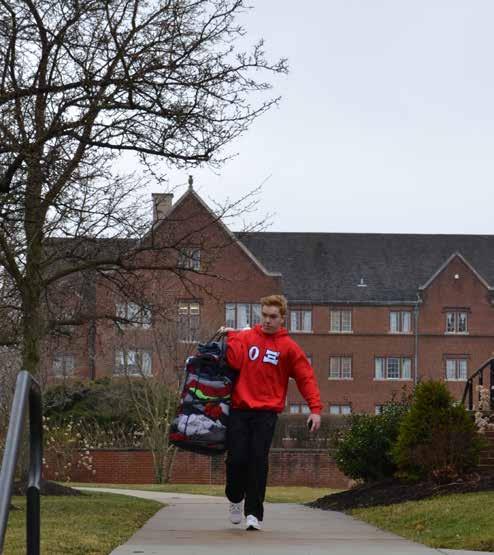
A student carries a basket of clothes as he prepares to leave campus on March 17 after the College announced that campus would be evacuated to protect the community from the growing COVID-19 pandemic.
On Monday, March 16, he sent another email. It was necessary, McNulty wrote, to “adjust our plans for campus life going forward … it will be necessary for all students to depart campus as soon as arrangements can be made.” The next day, cars, SUVs, and minivans clogged the driveways and parking lots outside residence halls in a light rain as students and their families packed up and moved out. There was some hope that students would be back in a month or so, that the crisis would abate and the College community would be together again in time to celebrate the Class of 2020 at Commencement in May, but the long faces and longer good-byes suggested it was a forlorn hope.
The pandemic is without a doubt the greatest crisis that McNulty has faced as president of his alma mater and a test of the vision, mission, and values of Grove City College. “It is a defining moment,” he said.
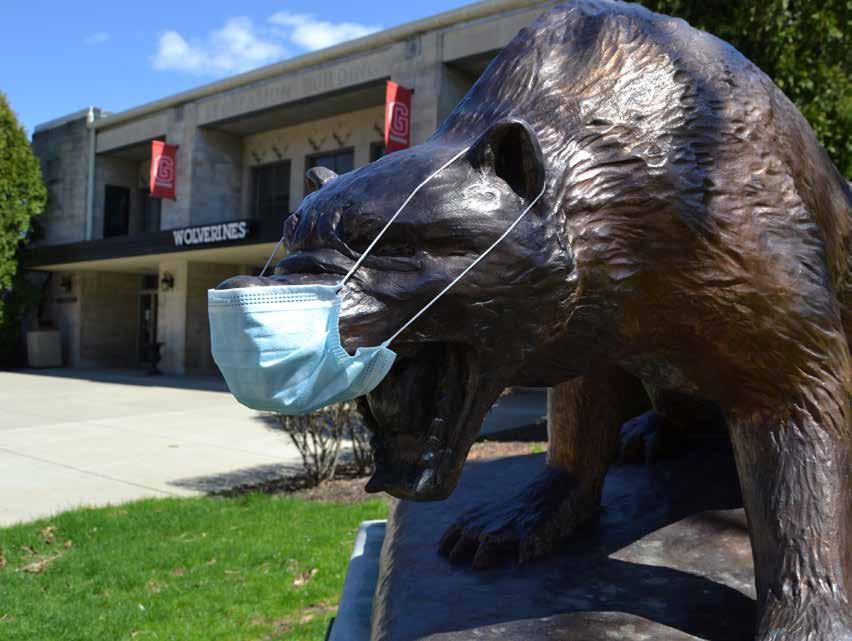
Before students left campus in March, someone put a surgical mask on the Wolverine mascot statue outside of the Physical Learning Center.
Grove City College has faced a series of defining moments over 14 decades. They form the milestones in the College’s journey from a tiny local prep school to a nationally known institution of higher learning regarded as one the country’s best colleges and universities by The Princeton Review and U.S. News and World Report. Brought on by circumstances beyond anyone’s control, like the pandemic, or created by leaders intent on fulfilling a historic mission to provide an excellent, affordable, and Christian education, these defining moments and the ways Grove City College has met them speak to a culture of faith, resilience and, sometimes, just plain grit. That culture has been tested over the last six months and the College has come out stronger academically, financially, organizationally, and spiritually.
– Paul J. McNulty ’80, College President
After making the call to send students home and move classes online, the first, and foremost, challenge was to deliver more than 800 courses designed for in-person classroom and laboratory instruction to more than 2,300 students scattered across dozens of states. Decisions made long ago and more recently made the transition far easier than anyone would have thought possible.
In 1994, in the early days of the digital revolution, Grove City College began providing each incoming student with a laptop computer. Those earliest machines, not much more than glorified word processers, were a way to attract students and prepare them for the changing workplaces they would soon inhabit. The laptop program was also intended create a culture of digital unity across campus, with faculty members and their students working with the same technology.
A quarter of a century later in 2019, the College decided to make a greater investment in digital instruction, creating an Office of Online Education and Graduate Studies and expanding its online offerings under the direction of Dr. Christy Crute. Early success in that realm and dedicated space for the office in the Hall of Arts and Letters made it easier to transition courses online and train faculty to deliver their courses via Microsoft Teams, which is part of the software used across campus. Within days the connections made in the classroom were renewed on split screens across the country. Greg Bandy, associate professor of Communication Arts, summed up the faculty’s resolve in a Collegian story by paraphrasing Winston Churchill: “We shall teach on the beaches, we shall teach in our living rooms, we shall teach in our backyards and on our streets, and yes, we may even teach in our pajamas; but we shall never surrender.”
– Greg Bandy, Associate Professor of Communication Studies
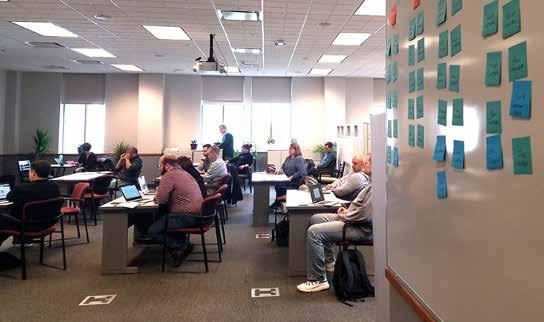
Faculty members undergo training for remote instruction using Microsoft Teams. Faculty familiar with online education mentored those who were new to the pedagogical modality, helping the College achieve a historic transition of more than 800 in-person classes in less than two weeks.
That optimistic take on the academic side was balanced by an unplanned financial reality for the College: providing refunds for unused room and board and other pandemicrelated expenses. Seniors and those who chose not to return in the fall were entitled to cash payments and returning students were offered a credit for the fall. All told it amounted to a $3 million hit in a budget with very little wiggle room. In April, McNulty and then-Board of Trustees Chair David R. Rathburn ’79 made an unprecedented joint appeal, aptly title “A Defining Moment.” It explained the situation and noted the fact that Grove City’s principled stance against federal support meant that it would get none of the billions earmarked by Congress to help colleges and universities weather the COVID-19 storm. The College needed help, not just to cover refunds and other expenses, they wrote, but to increase the amount of financial aid available in the fall for students whose financial situation was impacted by the pandemic.
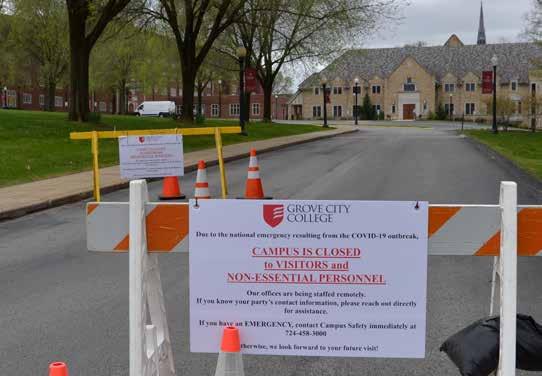
Entrances to campus were blocked after Pennsylvania officials ordered “non-essential” businesses closed during the pandemic.
Their call for support was answered by gifts large and small, including more than 150 students and families who donated their room and board refunds back to the College. “We were overwhelmed the community’s response to this unprecedented need. It is a real affirmation of what the College does and what it means to our alumni, our friends and our families. Their support in this crucial time will help hundreds of students continue to experience everything that’s great about a Grove City College education,” Jeffrey D. Prokovich ’90, vice president for Advancement, said. By the end of the fiscal, the College saw an increase over the previous year in unrestricted giving of more than $1 million.
On May 11, while students finished their finals online, a welcome announcement marked a turning point in this defining moment: The College would open as scheduled for the fall, with in-person classes and students back in their residence halls. That happy news belied the hard work ahead by a committee assembled by McNulty to develop plans to resume campus life safely and responsibly. The cross-disciplinary group of administrators, faculty, and staff spent months studying all aspects of the College’s operations and the shifting science around the coronavirus to develop policies and protocols that would allow Grove City College to deliver the learning and living experience that has been transformative for so many students and alumni. Their efforts, McNulty said, demonstrate the foundational values of excellence and community.
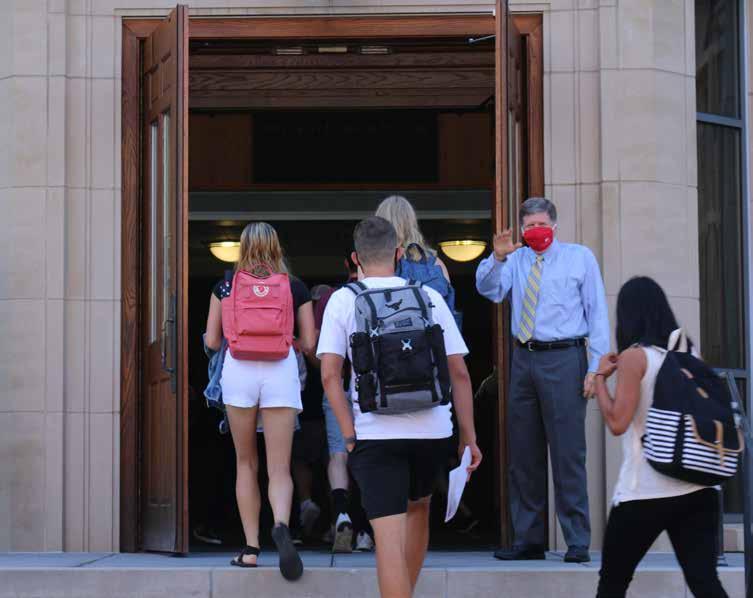
President Paul J. McNulty ’80 waves to students on the first day of fall classes at the entrance of the Hall of Arts and Letters. Months of planning preceded the return of students for in-person classes.
“There’s not much room for ‘good enough’ when you work at a plan and get down into these details,” McNulty said. “What I saw was that people’s capabilities really took off. They got their mission. They got direction and they moved forward.” The comprehensive final plan details policies and protocols to protect the community and addresses nearly every possible contingency. It requires measures that some might find restrictive, but are ultimately necessary in a season of caution.
In mid-August, students began to return to campus. Per the plan, they had all been screened and some tested for coronavirus under a partnership with Quest Diagnostics. The health of the entire campus community will be monitored until the pandemic subsides. As they moved back into their College homes, masks covered their smiles but it was clear that everybody was glad to be back. Barring another order to shut down from the state, McNulty is confident that the College will remain open through the fall. It is early days still, but it appears that College has risen to the challenge of another defining moment.
“The pandemic has sapped us of financial resources and diverted us strategically. It’s been a demanding presence for us, but there are benefits that have come out of it. Our technology was validated. Our faculty’s commitment to students was validated, and our students generally flourished. It was an opportunity, in a sense, to test the real capacity we have for our mission and we tested well,” McNulty said. “We’re collaborating well. I’ve seen our campus doing cross disciplinary work like it never has before and I think it’s going to help us. People are working as a team really well and that’s a huge organizational strength that I’ve benefited from as a leader.” The pandemic has also provided a chance to “get back to the basics,” he said. With limits on many of the activities that are a big part of the holistic campus experience, such as athletics and large group events, McNulty said students will be able to focus on what matters most: being in a classroom, learning from people who have extraordinary character and strong values.
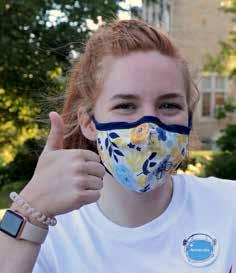
Orientation Board member Amanda Schmidt ’22 gives a thumbs up on move-in day, signaling a return of sorts to normal on campus.
In a year marked by protests and toxic politics in addition to the pandemic, that kind of mentorship is going to be more important than ever as students navigate what is, perhaps, the first defining moment of their lives. “Our students are returning to campus after having been through a really complicated cultural experience for the last six months, and I think in some ways there’s going to be some confusion and challenge about how to think about some really big issues,” McNulty said. “So it’s the job of the leadership of the College and the faculty and all those working with students to be as thoughtful as possible about how to help them think about our present situation.”
McNulty said he takes inspiration from his “favorite philosopher,” Wolverine Football Coach Andrew DiDonato ’10, who is telling players who won’t hit the gridiron until spring because of the pandemic to “focus on your vision, not your circumstances,” and Psalm 68:19 – “Blessed be the Lord who daily bears us up; God is our salvation.”
“It’s not He occasionally bears us up, or we hope He’ll bear us up. But He daily bears us up to get us through these things. A vaccine isn’t our salvation. Election Day isn’t our salvation. Racial justice isn’t our salvation. God is our salvation and that means we trust in something bigger than our circumstances. That’s what faithfulness looks like in a defining moment. It sees a bigger story at work than just what’s happening in front of your eyes.” ■


